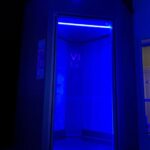Fitness Cryotherapy Trend Elite athletes like Dirk Nowitzki and Manuel Neuer spend time in the cold chamber. The trend in competitive sports is now making its way into their field. How you can incorporate cold training into your fitness program. We explain.
El fro is used in medicine to treat rheumatoid arthritis, skin diseases, migraines and depression. Top athletes use cold therapy, which is easy on the joints, to rejuvenate themselves and improve their performance.
How does cold therapy work?
Numerous conditions can benefit from cold therapy because it has anti-inflammatory, decongestant and pain-relieving effects. Bruises, contusions, hematomas, bursitis and joint injuries can all be effectively treated with cold. Since the 1980s, cold cameras have helped relieve rheumatism, arthritis, arthritis and general pain. This also helps regulate a hypersensitive immune system. In addition, cold therapy alleviates the suffering of patients with asthma, allergies, psoriasis, neurodermatitis, sleep disorders and depression.
The principle of cold therapy, also known as cryotherapy, is the targeted application of cold to achieve therapeutic effects. For example, after injuries, accidents or surgeries, cold treatments with ice or frozen compresses relieve pain while reducing swelling and the growth of bleeding in the tissues. The use of cold therapies is now a common adjunctive method in sports medicine. Combined with physical therapy, it stimulates metabolism, as is desirable in rheumatoid arthritis or inflammation, for example.
Cryotherapy relieves pain and restores mobility of degenerative arthritic joints. In case of tendonitis and muscle insertions, the healing process is supported by cold therapy. The application of cold stimulates muscle activity and reduces muscle tension in flâcid paralysis.
Fitness cryotherapy trend results of cold therapy:
- Improvement in general condition
- Reduction or elimination of pain and decrease in other symptoms related to inflammation (hinchazón and calentamiento)
- Improvement in general mobility and joint function in up to 60% of those treated
- Reduction in medication (glucocorticoids and nonsteroidal anti-inflammatory drugs) in up to 40% of patients
- Three to six months after the end of therapy, the effects were still noticeable.
- Prolongation of the treatment series made pain relief more durable.
- Improved joint mobility with long-lasting effects
- Application of cold therapy to the entire body for the following conditions
- Inflammatory, immune-mediated diseases (such as multiple sclerosis, psoriasis, espondylitis anquilosa, and rheumatoid arthritis).
- Fibromialgia
- Arthritis/spinal syndromes
- Tendopatas (tendon related diseases)
- Dolores Castro’s
- Atopic diseases (e.g. neurodermatitis)
- Associated with pain, primary and secondary sleep disorders
- Disturbances of balance and coordination of movement
- Primary cardiovascular complications (low arterial tension)
- Depression and psychological disorders
- Fitness Cryotherapy Trend
How does the cold training work?
Three minutes at a temperature of up to 160 degrees below zero in the cabin. Only the head, neck and limbs are raised. Alternatively, the entire body can move freely in the cold chamber. Before that, it often enters a pre-camera at 60 degrees below zero, and after 15 seconds it remains in the main camera at 110 degrees below zero for a maximum of three minutes.
There is no upper age limit for cold training. It is suitable, for example, for weight loss when combined with a diet plan developed by the Technical University of Munich specifically for fetal geneticists, as well as for strengthening the immune system, relieving pain and treating chronic diseases.
In the cold chamber before or after exercise?
The studies show that thanks to the cold chamber, the body recovers faster after a strenuous workout or competition, and injuries, even after surgery, heal faster and leave fewer scars. Before training, especially for strengthening the muscles, cold therapy enriches the muscles with the most oxygen and is therefore superior to exercises with calorie intake. In certain cases, it is advisable to obtain a certificate from the attending physician to confirm that there are no contraindications.
How much does cold therapy cost?
A single treatment lasts three minutes, and prices for this idea start at sixteen euros. However, prices and pricing models vary widely, ranging from single treatments without a contract to 10-treatment cards, and from monthly or annual payments to flat rates. In addition, there are limited time specials, discounts for first time registrations and trial training sessions.
Can I bill my health insurance for cryotherapy?
Cryotherapy is not yet a service supported by public health insurance. If it is necessary, the health insurance company will approve the assumption of the previously requested costs as part of an individual case assessment. For example, the AOK will cover the cost of treatment following an examination if a doctor prescribes certain cold or heat therapies as part of physiotherapy. The Therapeutic Products Directorate regulates the details. In this case, the insured person only has to pay the legally prescribed co-payment. In any case, it is worth discussing the assumption of costs in advance with the responsible health insurance company and the head physician or a designated specialist.






